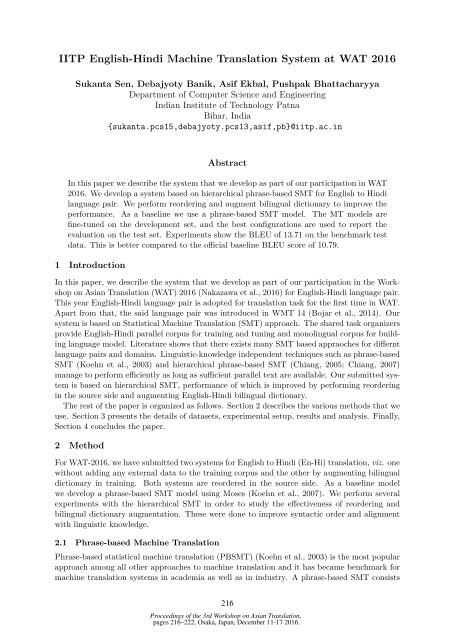December 11-16 2016 Osaka Japan
W16-46
W16-46
You also want an ePaper? Increase the reach of your titles
YUMPU automatically turns print PDFs into web optimized ePapers that Google loves.
IITP English-Hindi Machine Translation System at WAT 20<strong>16</strong><br />
Sukanta Sen, Debajyoty Banik, Asif Ekbal, Pushpak Bhattacharyya<br />
Department of Computer Science and Engineering<br />
Indian Institute of Technology Patna<br />
Bihar, India<br />
{sukanta.pcs15,debajyoty.pcs13,asif,pb}@iitp.ac.in<br />
Abstract<br />
In this paper we describe the system that we develop as part of our participation in WAT<br />
20<strong>16</strong>. We develop a system based on hierarchical phrase-based SMT for English to Hindi<br />
language pair. We perform reordering and augment bilingual dictionary to improve the<br />
performance. As a baseline we use a phrase-based SMT model. The MT models are<br />
fine-tuned on the development set, and the best configurations are used to report the<br />
evaluation on the test set. Experiments show the BLEU of 13.71 on the benchmark test<br />
data. This is better compared to the official baseline BLEU score of 10.79.<br />
1 Introduction<br />
In this paper, we describe the system that we develop as part of our participation in the Workshop<br />
on Asian Translation (WAT) 20<strong>16</strong> (Nakazawa et al., 20<strong>16</strong>) for English-Hindi language pair.<br />
This year English-Hindi language pair is adopted for translation task for the first time in WAT.<br />
Apart from that, the said language pair was introduced in WMT 14 (Bojar et al., 2014). Our<br />
system is based on Statistical Machine Translation (SMT) approach. The shared task organizers<br />
provide English-Hindi parallel corpus for training and tuning and monolingual corpus for building<br />
language model. Literature shows that there exists many SMT based appraoches for differnt<br />
language pairs and domains. Linguistic-knowledge independent techniques such as phrase-based<br />
SMT (Koehn et al., 2003) and hierarchical phrase-based SMT (Chiang, 2005; Chiang, 2007)<br />
manage to perform efficiently as long as sufficient parallel text are available. Our submitted system<br />
is based on hierarchical SMT, performance of which is improved by performing reordering<br />
in the source side and augmenting English-Hindi bilingual dictionary.<br />
The rest of the paper is organized as follows. Section 2 describes the various methods that we<br />
use. Section 3 presents the details of datasets, experimental setup, results and analysis. Finally,<br />
Section 4 concludes the paper.<br />
2 Method<br />
For WAT-20<strong>16</strong>, we have submitted two systems for English to Hindi (En-Hi) translation, viz. one<br />
without adding any external data to the training corpus and the other by augmenting bilingual<br />
dictionary in training. Both systems are reordered in the source side. As a baseline model<br />
we develop a phrase-based SMT model using Moses (Koehn et al., 2007). We perform several<br />
experiments with the hierarchical SMT in order to study the effectiveness of reordering and<br />
bilingual dictionary augmentation. These were done to improve syntactic order and alignment<br />
with linguistic knowledge.<br />
2.1 Phrase-based Machine Translation<br />
Phrase-based statistical machine translation (PBSMT) (Koehn et al., 2003) is the most popular<br />
approach among all other approaches to machine translation and it has became benchmark for<br />
machine translation systems in academia as well as in industry. A phrase-based SMT consists<br />
2<strong>16</strong><br />
Proceedings of the 3rd Workshop on Asian Translation,<br />
pages 2<strong>16</strong>–222, <strong>Osaka</strong>, <strong>Japan</strong>, <strong>December</strong> <strong>11</strong>-17 20<strong>16</strong>.



